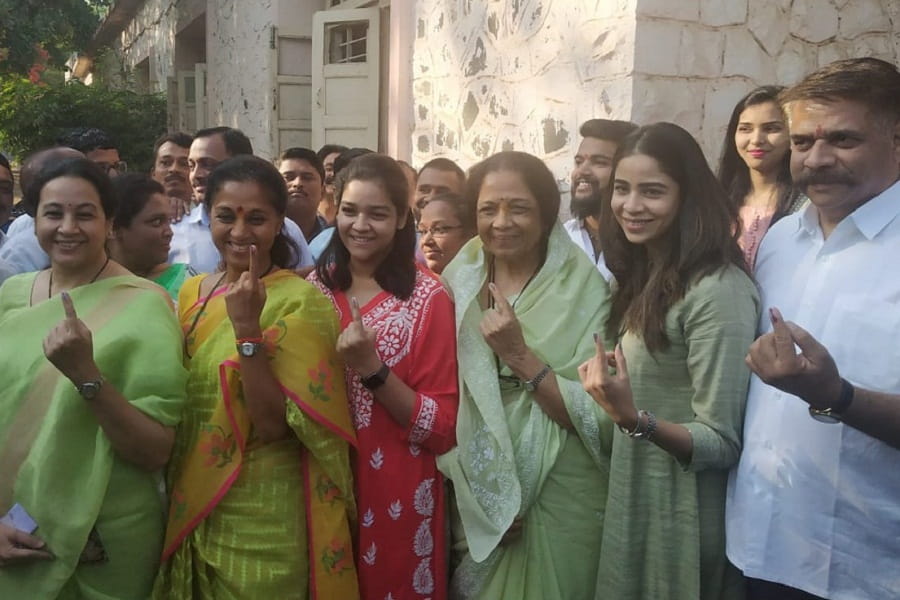Among EVM snags and stray incidents of violence, polling for 56% or 303 out of 543 Lok Sabha seats were completed, with the third phase of Election 2019. Navodita reports, exclusively for Different Truths.
As voting took place across 15 states and union territories in its third phase, poll pundits say that so far voting has been held in about 56% or 303 out of 543 Lok Sabha seats. There are reports of few EVM snags in Uttar Pradesh, Goa and Kerala and few incidents of violence across the country.
There have again been reports of violence in Bengal. A Congress worker named Piyarul Sheikh was stabbed to death in a clash with members of the Trinamool Congress outside a polling booth in Bhagwangola in Murshidabad. Seven others were also injured in the poll related violence. In a separate incident, Babulal Murmu, a polling agent was found dead at his house in Buniadpur, South Dinajpur. Authorities said he was a reserve officer, and this may be a case of suicide.
Samajwadi Party chief Akhilesh Yadav has alleged “criminal negligence” in the polling process, claiming all votes being polled on EVMs are being registered for the BJP.
Samajwadi Party chief Akhilesh Yadav has alleged “criminal negligence” in the polling process, claiming all votes being polled on EVMs are being registered for the BJP. Congress leader and Shashi Tharoor had voiced similar concerns after voting in Kerala where EVM glitches were reported within the first two hours of voting. Two people have also reportedly died while waiting in line to vote in Kerala.
In the meantime, let us see what political analysts and poll junkies are going to analyse until May 23?
Does high turnout imply strong anti-incumbency? There is no clear-cut indication to notice this trend.
Does high turnout imply strong anti-incumbency? There is no clear-cut indication to notice this trend. Unfortunately, there is no evidence to suggest that this wisdom holds true. In 2018, Milan Vaishnav and Jonathan Guy published a paper in the journal, Studies in Indian Politics, which looked at data from 18 major Indian state elections between 1980 and 2012. “Despite the popularity of the notion that citizens come out to the polls in greater numbers when they are motivated to punish the incumbent government, our analyses of three decades of electoral data uncover no such relationship,” the paper concludes.
Psephologist-turned-politician Yogendra Yadav, looking at national election data, arrived at the same conclusion, saying that the erroneous belief probably dates back to the general elections of 1967 and 1977, which saw anti-Congress waves. Let us now find out whether BJP needs a high turnout at all?
In a new book about Indian elections and polling, NDTV’s Prannoy Roy and Dorab Sopariwala look at whether turnout might say something about the relative success of the Bharatiya Janata Party.
In a new book about Indian elections and polling, NDTV’s Prannoy Roy and Dorab Sopariwala look at whether turnout might say something about the relative success of the Bharatiya Janata Party.
Analysing results from the Lok Sabha elections of 2004, 2009 and 2014, they conclude that “in each one of the three consecutive elections, the BJP+ performed much better in constituencies which had a low turnout.”
The authors suggest that one reason might be the intrinsic character of cadre-based parties, in this case counting the Rashtriya Swayamsevak Sangh as the BJP’s cadre, which are able to mobilise votes even if voter enthusiasm on average is low. “The key for the BJP is when low self-motivation amongst voters is widespread and leads to a low turnout; that’s when the BJP does best,” the authors say.
Centre for the Study of Developing Societies-Lokniti pre-poll survey appeared to show that BJP voters were much more enthusiastic about going out and voting.
Meanwhile, Centre for the Study of Developing Societies-Lokniti pre-poll survey appeared to show that BJP voters were much more enthusiastic about going out and voting.
Another important question is: is there really a ‘Modi wave’ as most people conjecture? As political scientist Neelanjan Sircar has pointed out, the places that saw the highest spike in turnout also corresponded to BJP victories, suggesting that a significant chunk of the new voters were BJP supporters, or specifically voting for Modi. Sircar wrote: “When many new voters were mobilised, the BJP was very likely to win the constituency. Voters also specifically came out to vote in constituencies where the BJP was competitive, and more so in constituencies in which the BJP was engaged in head-to-head battles with Congress.”
For Sanjay Kumar of the Centre for the Study of Developing Societies, this means that a lower turnout compared to 2014 should trouble the BJP, as was the case in six out of the eight Uttar Pradesh seats in the first phase, all of which it won five years ago. “I assume that in the first round a higher turnout would spell an advantage for the BJP in BJP-ruled states and a lower turnout might translate into the opposite for this party,” he wrote. “If that happens, the BJP would be down six in UP in the first round.”
As almost all will say though, turnout itself tells us nothing unless you also analyse it alongside more contextual factors specific to a constituency
As almost all will say though, turnout itself tells us nothing unless you also analyse it alongside more contextual factors specific to a constituency, as Kumar and Dipu Rai among others have attempted to do for the first phase.
Meanwhile for the BJP, North Bengal and parts of west Uttar Pradesh are emerging as the bellwether regions for the party. The BJP never got a foothold in Bengal, and even at the peak of its performance in 2014, it could win just two Lok Sabha seats, even though it got a respectable 17% of the vote share. One of these was won with support from a regional party, the Gorkha Janmukti Morcha (GMM). But this time around, Bengal is seen as one of the new green pastures for India’s ruling party and, several BJP leaders claim, whatever losses they take in north, central and western India — where it swept a majority of the seats five years ago — will be offset by gains in the eastern state.
If the BJP has to do well in Bengal, it must perform extremely well in the northern part of the state, where it has its largest support base.
Analysing further, the state remains under the dominant control of Trinamool Congress leader Mamata Banerjee and the BJP is largely dismissed as a party of India’s Hindi speaking population. If the BJP has to do well in Bengal, it must perform extremely well in the northern part of the state, where it has its largest support base.
There has been a good voter turnout during each of the last phases. We are now yet to see how these elections will fare until the last phase of polling. While psephologists and analysts exercise their grey cells, it’s time for voters to do their duty – be an informed citizen and vote!
Photos from the Internet






 By
By
 By
By

Navodita- Well analysed and concluded- we each one need to educate ourselves and others around us- and YES- exercise the privilege of voting which is also our right